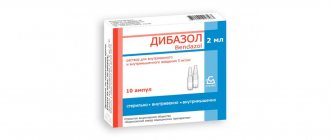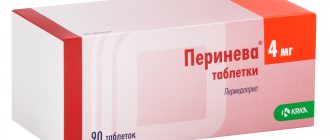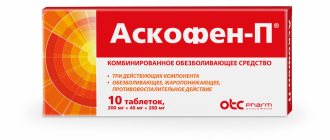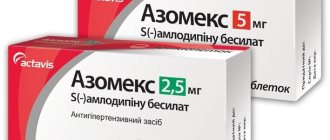Pharmacodynamics and pharmacokinetics
The active components of this drug are used for high blood pressure.
Ramiprilat (the active metabolite of ramipril ) inhibits ACE . In addition, it leads to a decrease in the release of aldosterone . Ramipril also causes a decrease in peripheral vascular resistance .
In most cases, the antihypertensive effect is noticeable within 1-2 hours. It lasts for 24 hours. The maximum degree of severity of the effect is achieved after 3-6 hours. With long-term therapy, the maximum effect is usually noticeable after about 3 weeks. With a long-term course of treatment, it is maintained for 2 years.
Hydrochlorothiazide is a thiazide diuretic . Possible patterns of its antihypertensive action include changes in sodium balance and renal vascular resistance, as well as decreases in extracellular fluid, plasma, and responses to angiotensin II and norepinephrine .
The maximum effect is noticeable after 3-6 hours and lasts up to 12 hours. The antihypertensive effect is achieved after 3-4 days of therapy and lasts a week after completion of the course. With long-term therapy, a decrease in blood pressure is achieved by using smaller dosages than needed for a diuretic effect. The decrease in blood pressure is accompanied by a slight increase in glomerular filtration renin activity in the blood plasma, as well as vascular resistance of the renal bed . When hydrochlorothiazide in high dosages, plasma volume decreases, as does glomerular filtration , mean arterial pressure , and renal blood flow. With long-term therapy in small doses, blood plasma volume, systemic vascular resistance and mean arterial pressure remain quite low, while the glomerular filtration and minute volume return to their previous values.
Contraindications
This product is not recommended for use if:
- cholestasis;
- history of angioedema , as well as hereditary/idiopathic ;
- significant problems with kidney function;
- anuria;
- primary aldosteronism;
- hemodialysis;
- galactose intolerance ;
- hereditary lactase or impaired absorption of glucose-galactose ;
- breastfeeding;
- pregnancy;
- childhood;
- significant disturbances in liver function;
- arterial hypotension;
- condition after kidney transplantation;
- intolerance to the components of the drug.
Hartil-D is prescribed with caution for aortic and mitral stenosis , systemic connective tissue diseases, severe lesions of the coronary and cerebral arteries, decompensated cor pulmonale, severe ventricular arrhythmias, suppression of bone marrow hematopoiesis, bilateral artery stenosis , gout , hyponatremia , hypercalcemia , renal failure , cirrhosis of the liver , unstable angina , chronic heart failure (fourth stage), decreased volume of blood volume , diabetes mellitus , old age, hypertrophic obstructive cardiomyopathy , hyperkalemia , stenosis of the artery of a single kidney , hypokalemia , artery disease , liver failure .
Side effects
When taking the drug at the beginning of therapy and after increasing dosages, severe arterial hypotension . Symptoms such as dizziness , blurred vision, general weakness, and fainting are possible. In addition, isolated cases of dynamic cerebrovascular accident, tachycardia , arrhythmias , myocardial infarction , palpitations, severe arterial hypertension , angina pectoris and shock have been reported. When using ACE inhibitors with arterial hypotension, cerebral hemorrhage and ischemic stroke .
The following adverse reactions are also possible:
- metabolism - hyperglycemia , increased acid levels, hypokalemia , gout , hyperkalemia , hypomagnesemia , hypercalcemia , hyponatremia , hyperchloremia ;
- nervous system – apathy , nervousness, headache , fatigue, feeling of weakness, drowsiness ;
- organs of vision - conjunctivitis , blepharitis ;
- cardiovascular system - significant decrease in blood pressure , swelling of the ankles;
- respiratory system - the appearance of a dry cough, bronchitis ;
- digestive system - nausea, vomiting, abdominal pain, dyspepsia epigastric cramps , constipation , dullness of appetite, thirst, diarrhea ;
- skin - urticaria , photosensitivity , itching ;
- urinary system - proteinuria ;
- reproductive system - decreased libido.
In rare cases, it is possible:
- circulatory system and lymph - decrease in hematocrit and hemoglobin , thrombocytopenia , eosinophilia , leukopenia , pancytopenia , agranulocytosis , hemolytic anemia (in case of deficiency of glucose-6-phosphate dehydrogenase );
- metabolism and nutrition - improper water-electrolyte balance, metabolic alkalosis , hypochloremia , increased levels of triglycerides in the blood serum and serum amylase , hypercholesterolemia , decompensation of diabetes mellitus ;
- nervous system - anxiety, imbalance, sense of smell, paresthesia ;
- organs of vision - transient myopia;
- hearing organs - ringing in the ears;
- cardiovascular system - dynamic cerebrovascular accident, fainting, thromboembolic complications , vasculitis , thrombosis , exacerbation of Raynaud's disease , venous disease, embolism ;
- respiratory system - shortness of breath, rhinitis , glossitis , allergic interstitial pneumonia , sinusitis , pharyngitis , bronchospasm , Quincke's edema , pulmonary edema;
- digestive organs - intestinal obstruction, dry mouth, taste disturbance, sialadenitis , vomiting, inflammation of the mucous membranes, hemorrhagic pancreatitis ;
- liver - increased activity of bilirubin and liver enzymes, cholestatic jaundice , cholecystitis , hepatitis , liver necrosis
- skin - systemic lupus erythematosus , erythema multiforme , facial flushing, peripheral edema, increased sweating, Lyell's syndrome , exacerbation of psoriasis , Stevens-Johnson syndrome , allergic reactions , alopecia , onycholysis ;
- musculoskeletal system and connective tissue - muscle spasm, arthralgia , arthritis , myalgia , muscle weakness, paralysis ;
- urinary system - deterioration of kidney function, dehydration, increased levels of residual nitrogen and serum creatinine , nephrotic syndrome , acute renal failure , oliguria , interstitial nephritis ;
- reproductive system - impotence ;
- others - anaphylactic reactions.
Quincke's edema in most cases appears in patients of the Negroid race. In addition, a small group experiences angioedema of the face and oropharyngeal area due to the use of ACE inhibitors .
In case of pronounced side effects on the skin, you should consult a specialist.
Medical observation is indicated for jaundice liver enzyme activity .
Instructions for use Hartil-D (Method and dosage)
The medicine is intended for single use in the morning with a sufficient amount of liquid. The instructions for use of Hartil-D indicate that food intake does not affect its action. Tablets cannot be cut into pieces.
You should take this medication only after your doctor has selected the dosage and regimen. As a rule, to start the course, 2.5 mg of ramipril and 12.5 mg of hydrochlorothiazide . The maintenance dosage is the same or twice as high, respectively, for each active substance. The dose is increased if necessary with a minimum interval of 3 weeks. The recommended maximum dosage per day is 5 mg ramipril and 25 mg hydrochlorothiazide .
For elderly people, as well as for those who have problems with the kidneys and liver, the doses of each component are selected individually before switching to the combined drug Hartil-D. Its dosage should be minimal.
Use of the drug Hartil
The tablets should be swallowed whole without chewing, with plenty of liquid, regardless of meals. AH (arterial hypertension) . The recommended starting dose is 2.5 mg 1 time per day (1 tablet 2.5 mg). Depending on the patient’s condition, the daily dose can be doubled every 2–3 weeks. The usual maintenance dose is 2.5–5 mg/day (1 tablet 2.5 mg or 5 mg). The maximum daily dose is 10 mg. If it is necessary to use a dose of 5 mg, instead of further increasing the dose of Hartil, consider combining it with other antihypertensive agents, such as diuretics or calcium channel blockers. Congestive heart failure. The initial recommended dose is 1.25 mg 1 time per day (1 tablet 1.25 mg). Depending on the therapeutic effect, the daily dose can be increased, doubling it every 2-3 weeks. The maximum daily dose should not exceed 10 mg. Heart failure after acute myocardial infarction. It is recommended to start using the drug on days 2–9 after myocardial infarction. The initial dose is 1.25–2.5 mg 2 times a day (1 tablet 1.25 or 2.5 mg). Depending on the therapeutic effect, the initial dose can be doubled to 2.5–5 mg (1 tablet of 2.5 or 5 mg) 2 times a day. The maximum daily dose should not exceed 10 mg. Severe non-diabetic or diabetic nephropathy, as well as its initial stages. The recommended starting dose is 1.25 mg 1 time per day (1 tablet 1.25 mg). Depending on the therapeutic effect, the dose can be increased by doubling the daily dose every 2-3 weeks. The recommended maximum daily dose is 5 mg. Prevention of circulatory disorders of the myocardium and brain - myocardial infarction, stroke or threat of death due to cardiovascular disorders . The initial dose is 2.5 mg 1 time per day (1 tablet 2.5 mg). Depending on the tolerability of the drug, after 1 week of use the daily dose should be doubled (1 tablet 5 mg). This dose can be doubled again after 3 weeks of use. The recommended maintenance dose is 10 mg 1 time per day (1 tablet of 10 mg or 2 tablets of 5 mg). Elderly patients. The use of the drug in elderly patients taking diuretics and/or with signs of heart failure, as well as with impaired liver or kidney function requires special monitoring. Dosage should be set individually, depending on the response to the drug. Patients with renal failure. With a moderate decrease in renal function (creatinine clearance 20–50 ml/min per 1.73 m2 of body surface), the initial dose is 1.25 mg 1 time per day (1 tablet 1.25 mg). The maximum daily dose should not exceed 5 mg. If it is not possible to determine creatinine clearance in a laboratory, it can be calculated from the serum creatinine level using the Cockroft equation: For men. Creatinine clearance (ml/min) = [body weight in kg • (140 – age) : 72 • serum creatinine (mg/dl)]. For women. The calculation result for men is multiplied by 0.85. Patients with impaired liver function. At the beginning of treatment with Hartil, patients with impaired liver function require careful medical supervision. The maximum daily dose in such cases should not exceed 2.5 mg. In patients receiving diuretic therapy, the possibility of temporarily discontinuing or reducing the dose of diuretics should be considered for at least 2-3 days (or more depending on the duration of action of the diuretics) before starting to use Hartil. In patients recently treated with diuretics, the usual starting dose is 1.25 mg (1 tablet 1.25 mg). In patients with fluid and electrolyte imbalance, severe hypertension and in cases where a significant decrease in blood pressure cannot be allowed (for example, with stenosis of the coronary or cerebral arteries), low initial doses, for example 1.25 mg / day, should be given preference.
Overdose
When using this drug in excess dosages, the following are possible: urinary retention, significant decrease in blood pressure , convulsions, arrhythmia , shock, intestinal obstruction, electrolyte imbalance, coma , paresis , bradycardia , renal failure .
The treatment regimen is selected individually. As general measures, gastric lavage, sodium sulfate and activated charcoal may be prescribed. In addition, maintenance therapy is used.
Ramipril is removed from the body through dialysis .
If there is a significant decrease in blood pressure, fluid volume is restored with saline. If this does not give the desired result, intravenous administration of angiotensin II and catecholamines . It is very important to monitor BCC , acid-base balance , diuresis , electrolyte and glucose levels in the blood. With severe bradycardia , a pacemaker is installed. If hypokalemia , potassium levels should be restored to normal.
For life-threatening angioedema, the following measures are taken:
- subcutaneous administration of up to 0.5 mg of epinephrine or slow intravenous administration of Adrenaline with monitoring of ECG and blood pressure ;
- administration antihistamines ;
- intravenous or intramuscular administration of glucocorticoids ;
- adrenaline can be supplemented with a C₁-inactivator if the patient has a deficiency.
Overdose of the drug Hartil, symptoms and treatment
Symptoms: severe hypotension, shock, electrolyte imbalance, renal failure. Treatment of overdose depends on how and when the drug is administered, as well as the type and severity of symptoms. Treatment: general measures - gastric lavage, use of sorbents, sodium sulfate (if possible during the first 30 minutes). It is necessary to monitor and support the vital functions of the patient’s body in intensive care conditions; for hypotension, you can also administer catecholamines and angiotensin II, place the patient on his back with the foot end of the bed elevated, and administer additional fluid and sodium. Hemodialysis is ineffective.
Interaction
The combination of ramipril and diuretics may lead to an enhanced antihypertensive effect. In addition, a significant decrease in blood pressure . So it is advisable to avoid this combination.
The hypotensive effect may be enhanced when ramipril concomitantly with organic nitrates or vasodilators . In addition, it is weakened by the use of NSAIDs . to impaired renal function in combination with ramipril In rare cases, renal failure . The risk of its development increases when Hartil-D is taken simultaneously with Allopurinol ( leukopenia ) and Cyclosporine . The latter remedy, as well as Lovastatin and trimethoprim, can also cause hyperkalemia . Leukopenia also develops when Hartil-D is combined with Procainamide , immunosuppressants and cytostatics .
The interaction of ramipril with lithium preparations leads to an increase in the level of lithium in the blood serum, and the development of toxic effects is possible. This combination is not recommended, but if it is unavoidable, monitoring of the patient's condition is required. Lithium toxicity may be exacerbated by the use of thiazide diuretics .
Arterial hypotension is enhanced by the interaction of ramipril with certain anesthetics , antipsychotics and tricyclic antidepressants .
The patient's condition should also be monitored when Hartil-D is combined with sympathomimetics . And when interacting with hypoglycemic agents, their effect may increase until hypoglycemia . This is especially possible when starting therapy and in cases of renal impairment.
The combination of dialysis with ACE inhibitors is contraindicated, as this can lead to anaphylactoid reactions.
Hydrochlorothiazide, when interacting with Amphotericin B , GCS , laxatives, Carbenoxolone or Corticotropin , can lead to electrolyte imbalance. And when combined with calcium salts, the appearance of hypercalcemia , with cardiac glycosides - digitalis intoxication and hypokalemia , with Sotalol - arrhythmia , with salicylates - an increase in their toxic effect on the central nervous system.
The absorption of hydrochlorothiazide is reduced by the action of cholestyramine resins and Colestipol . Therefore, between taking them it is necessary to leave a gap of one to several hours.
This active substance Hartil-D also enhances the effect of non-depolarizing muscle relaxants .
In addition, the antihypertensive effect of the drug is reduced when combined with sodium chloride.
Special instructions for the use of the drug Hartil
After taking the first dose, as well as when increasing the dose of a diuretic and/or ramipril, patients should be under medical supervision for 8 hours to avoid the development of an uncontrolled hypotensive reaction. In patients with heart failure, taking the drug can lead to the development of severe arterial hypotension, which is accompanied by oliguria or azotemia and rarely by the development of acute renal failure. The lower limit of systolic blood pressure during therapy in the early period of myocardial infarction is considered to be 100 mm Hg. Art. Patients with malignant hypertension (arterial hypertension) or concomitant severe heart failure should begin treatment in a hospital setting. Before and during therapy with ACE inhibitors, it is necessary to monitor the hemogram with determination of the absolute content of leukocytes and leukocyte form (at least once a month in the first 3-6 months of therapy) in patients with an increased risk of neutropenia - with impaired renal function, collagenosis, and also at the first signs of infection). If neutropenia is confirmed (neutrophil count ≤2000/μl), ACE inhibitor therapy should be discontinued. Before and during treatment, monitoring of blood pressure, renal function, K+, creatinine, urea in the blood plasma, control of hemoglobin in the peripheral blood, concentrations of electrolytes and liver enzymes is necessary. Caution must be exercised when prescribing the drug to patients on a low- or salt-free diet (increased risk of developing arterial hypotension). In patients with reduced blood volume (due to diuretic therapy) - limiting salt intake, dialysis, vomiting, diarrhea - symptomatic hypotension may develop. Transient hypotension is not a contraindication for continuing treatment after stabilization of blood pressure. If severe hypotension reoccurs, the dose should be reduced or the drug discontinued. The use of AN69 dialysis membranes in combination with ACE inhibitors is not recommended (due to the possibility of developing anaphylactoid reactions in patients). If there is a history of angioedema not associated with taking ACE inhibitors, these patients have an increased risk of developing it when taking the drug. The safety and effectiveness of the drug in children are not known. During pregnancy and breastfeeding. Taking the drug Hartil is contraindicated during pregnancy, therefore, before starting use, the patient should be excluded from pregnancy, and it is also necessary to protect against pregnancy by using an adequate method of contraception. In case of planned pregnancy, you must stop taking Hartil and switch to using an alternative drug. If pregnancy occurs while taking Hartil, it should be discontinued immediately (before the end of the first trimester) and replaced with a drug that does not contain an ACE inhibitor to avoid the risk of fetal damage. The drug Hartil is contraindicated during breastfeeding. Ramipril is excreted into breast milk, so if the mother needs to use the drug, breastfeeding should be stopped. The ability to influence reaction speed when driving vehicles or other mechanisms. During treatment, you should refrain from driving vehicles and activities that require increased concentration and speed of psychomotor reactions, since dizziness may occur, especially after the initial dose of an ACE inhibitor in patients taking diuretics. Caution should be exercised when performing physical exercise or during heat due to the risk of dehydration and hypotension due to decreased fluid volume in the body. It is not recommended to drink alcoholic beverages during treatment with the drug. Before surgery (including dentistry), you should warn the surgeon/anesthesiologist about the use of the drug.








